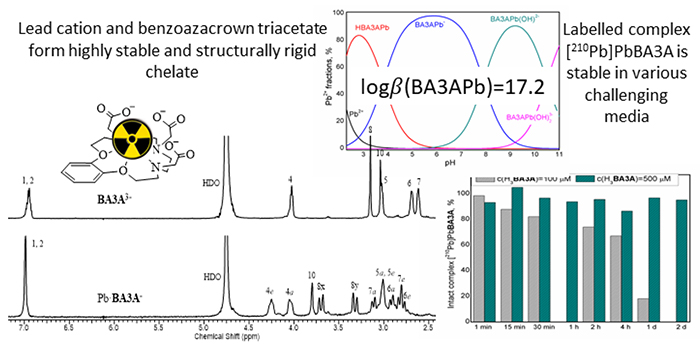Bayirta V. Egorova,a@ Lyubov S. Zamurueva,a Anastasia D. Zubenko,b Anna V. Pashanova,b,c Zeena S. Pillai,d Olga A. Fedorova,b,c and Stepan N. Kalmykova
aLomonosov Moscow State University, 119991 Moscow, Russian Federation
bA.N. Nesmeyanov Institute of Organoelement Compounds of Russian Academy of Sciences, 119991 Moscow, Russian Federation
cD.I. Mendeleev University of Chemical Technology of Russia, 125047 Moscow, Russian Federation
dDepartment of Chemistry, Amrita School of Arts and Sciences, 682024 Kerala, India
@Corresponding author E-mail: bayirta.egorova@gmail.com
DOI: 10.6060/mhc210440e
Macroheterocycles 2021 14(2) 157-163
Triacetate of 15-benzoazacrown-5 compound (H3BA3A) is a new ligand that has shown advantages towards chelation of some cations. In this paper H3BA3A was consequently studied for binding of lead cation. With respect to nuclear properties of 212Pb radioisotope it can be used for therapy of various oncological diseases mainly due to alpha-emitting daughter radionuclide 212Bi. Complexes of such radionuclides are considered as parts of targeted radiopharmaceuticals that can be conjugated with biomolecules to provide address delivery to cancerous tissues. Medical radionuclides are commonly short-lived and biomolecules are often heat-sensitive. That is why fast and stable complexation of trace amounts of lead cations in biologically relevant media without additional heating higher than 37 °C is important and challenging task. At the beginning we determined complexation constants in wide pH range including different protonated and hydrolyzed complex species via potentiometric titration technique. The obtained values are high enough for lead chelates logβ(BA3APb–) = 17.2 (1). Structural features of complex in aqueous solution were established due to 1H and 13C NMR spectroscopy. High resolution of obtained spectra and comparison with spectrum of deprotonated ligand shows presence of one rigid conformer of complexed form in the aqueous solution with Cs symmetry. In order to study labelled compounds we used longer lived isotope of lead 210Pb isolated from solution of 226Ra. Using thin layer chromatography and gamma-spectrometry it was found that 100 μM of ligand is enough to completely chelate 210Pb in the tracer concentration related to radiopharmaceutical concentration of 212Pb. According to pH speciation obtained in complexation constant determination, pH 5.5–6 was selected for labelling experiments. Noteworthy, the labeled compound was obtained within 1–5 minutes at room temperature as well as upon heating at 90 oC. Macrocyclic H3BA3A demonstrates fast complexation apparently due to larger crown cavity compared to cyclen cavity in H4DOTA. This was indirectly shown in potentiometric titration where waiting time for curve’s points was no longer than 5 minutes indicating that equilibrium was achieved within 5 minutes. In order to evaluate possible trans-chelation and trans-metallation of complex in living organism we performed challenging experiments in static conditions: in presence of nine-fold excess of serum proteins, biologically relevant cations 5 mM Ca2+, 5 mM Mg2+, 0.1 mM Zn2+, 0.1 mM Cu2+, 0.1 mM Fe3+ and isotonic solution of 0.15 M NaCl. It was shown that the 100 % intactness of complex can be kept for up to two days of incubation in competing media. Summarizing, the H3BA3A forms highly stable complex with lead cation not only in model solution, but also in presence of challenging agents. This stability is provided by high stability constants and rigid structure in solution.

References:
